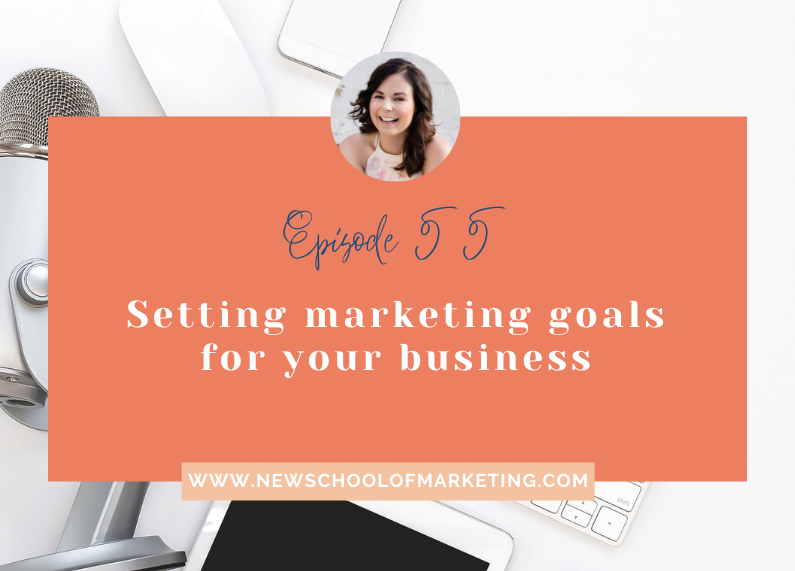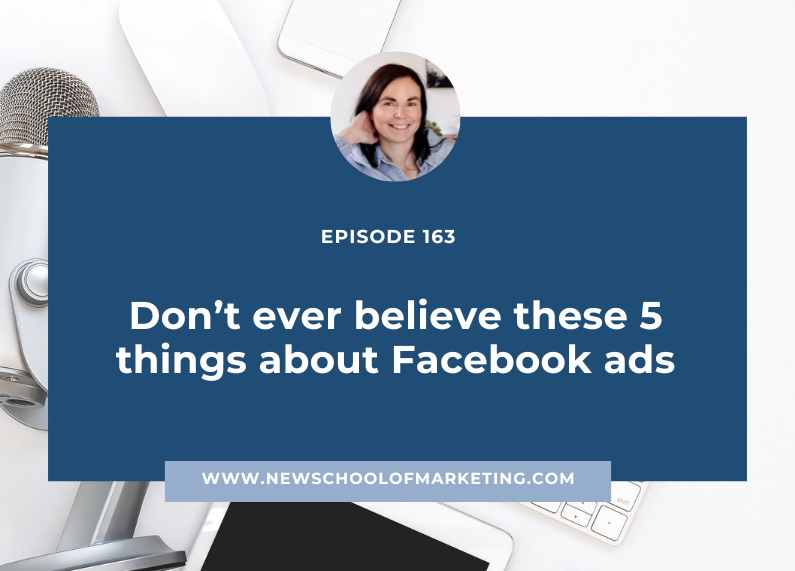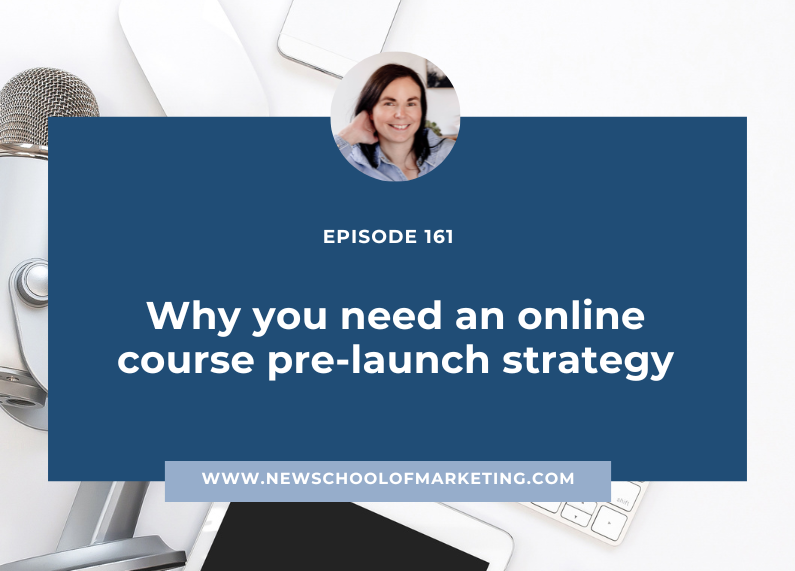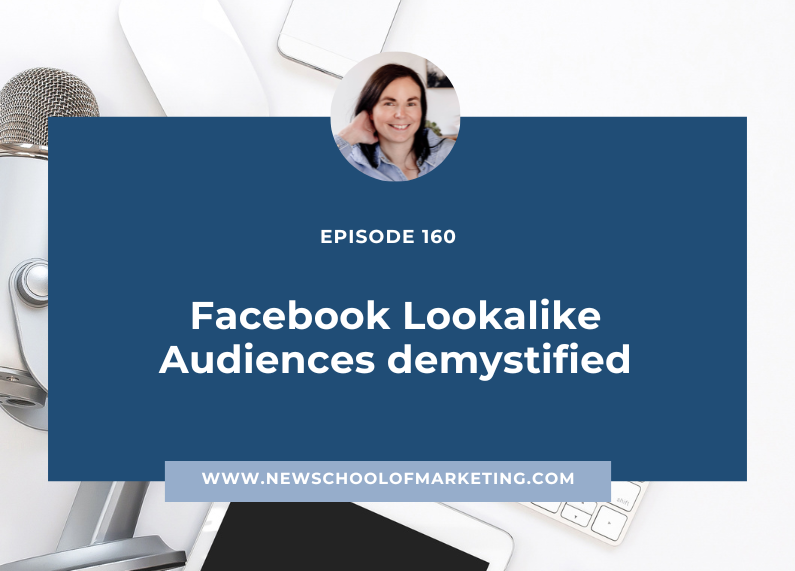
I’m not sure if you set goals in your business and if you specifically set marketing goals, but hopefully after today’s episode you will.
I generally do my planning and goal setting in November/December of the previous year, although this year I was a bit late because the pandemic had me all shaken up and it was kind of hard to see where things were going.
And right now that’s still the case for many of us, but I’ve adapted and I now plan only 3-6 months ahead instead of 12.
I still have the overall big picture and 12 month plan in my head but then I do my planning every 90 days and every month. Because things keep changing I feel the need to be more flexible.
So, what are marketing goals and how do you set them for your business?
The way I see marketing goals is that they are a part of your marketing strategy or plan.
Generally, marketing goals fit into 5 categories:
- Raise brand awareness
- Generate high quality leads
- Grow and maintain authority
- Increase customer value
- Empower staff/customers to become brand ambassadors
Tune in to hear more 🎧
Connect with me
Website: www.newschoolofmarketing.com
Facebook: @newschoolofmarketing
Facebook group: @newschoolofmarketing
Instagram: @bianca_mckenzie
Love the New School of Marketing Podcast?
Let’s be honest and upfront, because you know that’s what I’m all about. Podcast reviews are super important to iTunes and the more reviews we receive the more likely iTunes will reward us with better reach.
I want to reach more course creators, store owners and awesome business builders that can add extreme value to our awesome insiders. I already love that you’re here and ready to rock your business, but I’d be extremely grateful if you would review me on iTunes and SUBSCRIBE!
Can’t wait to teach you everything I know about online marketing!
Transcript
Hey there, I hope you’re well and thanks for tuning in to the New School of Marketing podcast.
As I’m preparing this podcast I have a sick toddler at home and thankfully it doesn’t happen very often but when it does I’m always reminded that one of the reasons for running my own business is that I can be there for my little one when she needs me.
I love what I do, but I love the freedom even more.
In today’s episode I want to talk to you about marketing goals.
I’m not sure if you set goals in your business and if you specifically set marketing goals, but hopefully after today’s episode you will.
I generally do my planning and goal setting in November/December of the previous year, although this year I was a bit late because the pandemic had me all shaken up and it was kind of hard to see where things were going.
And right now that’s still the case for many of us, but I’ve adapted and I now plan only 3-6 months ahead instead of 12.
I still have the overall big picture and 12 month plan in my head but then I do my planning every 90 days and every month. Because things keep changing I feel the need to be more flexible.
So, what are marketing goals and how do you set them for your business?
The way I see marketing goals is that they are a part of your marketing strategy or plan.
Generally, marketing goals fit into 5 categories:
- Raise brand awareness
- Generate high quality leads
- Grow and maintain authority
- Increase customer value
- Empower staff/customers to become brand ambassadors
When I work with small businesses, they often only focus on one or a few of these and often don’t create an overall strategy that incorporates them all.
Your short term focus will probably be on building awareness and generating sales, but there are so many other opportunities available.
I especially love the goal of increasing customer value, because it doesn’t require you to do all the heavy lifting of getting customers to find you, get to know you, then like and trust you before they decide to purchase.
Because let’s be honest, that’s hard work and the majority of our audience won’t buy from us.
Only around 2-4% of our audience will spend money in your store, and only 1-3% purchase our online course, so you’re doing a ton of work upfront.
So rather than focusing solely on brand awareness and generating new leads, why not come up with strategies to increase the customer value of your existing customers. These are the people that have already bought from you, they already know – like and trust you. How can you get those people to spend more in your store and ultimately become brand ambassadors?
So when you’re setting goals for your business and you’re creating a marketing plan, try to incorporate the 5 different categories of marketing goals.
Inside each of these categories you can specify what you want that to look like for your business.
For example; by setting a goal to raise brand awareness you can tie that into your social media content and set measurable goals such as the increase in number of followers, increase in engagement and/or a higher number of DMs.
The reason I’m mentioning this is that I see a lot of business owners posting on social media for the sake of posting but there’s often no clear intention behind the posts. If you constantly post to sell, you’re missing out on what social media is all about. It’s about being social and building relationships and communities.
When setting your marketing goals, you should be intentional about what you post and how it fits in with your overall business goals.
If you haven’t yet set any marketing goals for your business, now is the perfect time to do so. We’ll be going into Q4 soon, which is generally one of the busiest times for marketers because everyone wants a slice of the pie.
Shouting into the void in Q4 isn’t going to do anything for your business. If you want to connect with your ideal customers, you need a strategy to stand out from the crowd.
My clients that have the highest launch sales or store sales are the ones that put a lot of thought and personality into their socials and email marketing. They’re not simply posting sales posts, they’re building relationships by being personable.
So, how can you set marketing goals for Q4 that will actually get you results?
Let’s work on this together. Grab a pen and paper (or do it later if you’re not currently sitting down).
Of course your goals need to fit in with your overall business goals and marketing strategy, but you know your business best and you know what you’d like to achieve in the next 90 days.
With that in mind, let’s look at the 5 categories and work on setting our marketing goals.
- Raise brand awareness
Brand awareness is usually a tricky one, as traditionally it’s very much about big brands and how well people know them and can recall them in certain situations.
Let’s look at what it means for small businesses and how you can work on brand awareness.
The main aim for brand awareness is to be known for something and for your ideal customer to think of you when they need that specific thing you provide.
For example, I’ve become known for Facebook ads. That doesn’t mean that I can’t offer other services, but I’m known for one thing.
When marketing yourself, it’s a really good idea to focus on one thing so that you can become known for that.
So think about what you do, what’s ONE THING that you’d like to be known for?
Then focus on creating brand awareness content that only points to that one thing.
In how many ways can you talk about that one thing?
Think about how you can educate people about that one thing.
Think about how you can inspire people with your one thing.
Think about how you can showcase client results or testimonials about your one thing.
In how many ways can you tell a story about your one thing?
To create brand awareness, you want to focus on telling people about your one thing without trying to sell your one thing. Or at least not all the time.
- Generate high quality leads
Lead generation is one of my favourite things to do.
Most of my advertising clients come to me for lead generation, because they know the value of getting someone into their community so that they can build relationships and nurture them until they are ready to purchase.
Lead generation is not just about getting numbers on your database.
It’s about getting the RIGHT people on your database.
I know that most businesses want to make sales, and I’m totally onboard with that. I want to make sales too. But I know that not everyone is ready to purchase right away.
In fact, the majority of people will not be ready to purchase when they first discover your business. On average it takes 7-12 touch points before someone is ready to buy.
So, how can you attract someone to your business and keep in touch with them until they’re ready to buy?
This is why lead generation is so important.
When creating your content, think about how you can build a relationship with your audience so that they will want to follow you and read your posts as well as engage with you?
Because you already know that they won’t buy immediately, you need to think of ways to get them to come back so they see more of your content.
Ideally you want them on your email list so that you have more control over getting them to see your content.
How can you get them interested enough to join your list?
Work on creating content to invite people to join your community.
- Grow and maintain authority
As part of your marketing goals, you want to focus on building authority in your niche. It’s closely linked to brand awareness, but this is more about you and your personal brand.
You want to be known as the go-to person for what you offer.
While brand awareness has a place on social media and by creating content, building authority comes more from public speaking.
So how can you build your authority in the next 90 days?
Think about guest blogging, being a podcast guest speaker, being featured in a magazine or newspaper or doing some public speaking, even virtually.
It might be scary the first time, but once you’ve done one you’ll get into it and want to do more. At least that’s how it was for me.
Find some publications, podcasts or other media outlets that align with your work and your audience, without being in direct competition. Write your pitch by focusing on how you can contribute to the publication’s audience. Don’t make it about you, make it about them.
And send a few pitches. You’ve got this!
- Increase customer value
As I said earlier, this is one of my favourite goals.
You’ve already done the hard yards by winning these customers over, now think about how you can increase their value.
How can you sell more or something else to them?
Brainstorm a few ways to sell more.
Maybe you’re an eCommerce store and you have matching products. For example, your customer purchased earrings and you have a matching necklace. Try to upsell that.
Or maybe you’re a course creator and you’ve sold someone a course. You could offer them some 1:1 time as an upsell, or potentially a group workshop. Or even a done for you or done with your version.
- Empower staff/customers to become brand ambassadors
If done right, your staff and your customers can be so in love with your business that they’ll tell others about it.
That’s an absolute honour. It’s so amazing when you’ve done such a great job that others want to recommend your brand.
Think about how you can get more people to spread the word about your business.
And as a side note, the most important thing about this is that you need to offer an exceptional product and absolutely stellar customer service.
People want to talk about businesses that they had a good experience with just as much as they want to warn others about a bad experience.
How can you give your customers and staff the best possible experience?
Wow, that was quite the exercise and I hope you got something out of that.
Setting marketing goals might not be your favourite thing but it’s so incredibly important for your business. After all, how are people going to find you if you don’t tell them about it?
Keep your ideal customer in mind and focus on building relationships. As long as that’s your main focus, you’ll be building longevity into your business.








0 Comments